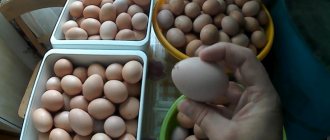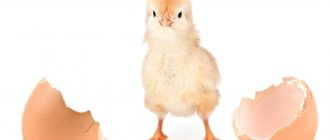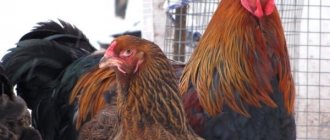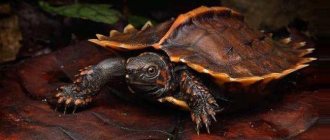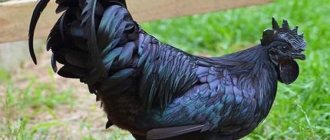The Haysek breed was obtained by Dutch breeders. To obtain crosses they used White Leghorns, Rhode Island, and New Hampshire. As a result, two directions were developed - egg White and meat-egg Brown. The time when selection appeared was the 70s of the 20th century; chickens came to Russia in 1974.
These crosses have a calm character, are unpretentious in maintenance and care, and have a relatively low cost. They also have certain disadvantages - for example, the lack of instinct to incubate eggs. You can learn more about Haysek chickens, their varieties, characteristics of growing and feeding below.
Characteristics and description of the Haysek chicken breed
Hayes have an interesting appearance and a certain set of features.
Appearance of a rooster and a hayse hen
The Hays are distinguished by four-lineality and three-fold autosex. It is possible to determine the sex of chickens already at one day of age - females fledge noticeably faster than males, also the down of hens is brown, and that of roosters is light or yellow. Hisek crosses have a luxurious comb and silky plumage. The body is compact but strong, the silhouette is slightly elongated and neat.
Hens are always smaller than cockerels; you will not grow more than 2 kg. Males can reach 2.5 kg.
Advantages and disadvantages of cross chickens
Crosses have a whole set of positive characteristics. Among them:
- Excellent egg production - one hen will give you at least 300 eggs of 70 g per year.
- Resistance to infections and viruses. Infectious diseases are possible, but, as a rule, the risks of their occurrence can be reduced to “no” through proper care.
- Low body weight.
- Calm character.
- Excellent decorative characteristics.
- The survival rate of young animals is 96%.
- Early puberty.
Hayes lay eggs at the age of 20 weeks - this is almost a record figure.
Disadvantages of the direction:
- The livestock needs regular updating, since Haysek is not a separate breed, but a cross. In addition, purebred offspring quickly lose their parental characteristics.
- Demanding on diet and quality of feed. Read about feed for laying hens in this article.
Character
Hays are very peaceful birds; they do not start fights among themselves and do not enter into conflicts with other animals. It is for this reason that they can be safely released for free range.
Breeding Features
From the first days after the chicks hatch, it is possible to determine their sex. Hens fledge faster than roosters and have a darker shade of plumage. Chickens become sexually mature in the fourth month of life.
Caring for chicks
Hisex Brown chicks
The eggshell is so strong that not all chickens are able to get out of it on their own. At the right time, it is worth cracking the shell from the outside to prevent the chick from dying. The survival rate of chickens is 95%.
It is better to keep chickens in a separate room. For 1 cu. m is allowed to keep six chickens. In the first days, the chicks are housed in a cardboard box or wooden box. They should not be cramped so that the chicks do not trample each other. The bottom is covered with newspapers in several layers - this makes it easier to clean up after the chicks.
In winter, the temperature in the place where chickens are kept is 4 degrees higher than that of adults - +16 °C. In summer, the temperature remains at +26 - +28 °C. Light sources should be positioned so that the chicks do not overheat. Overheating causes chicks to become drowsy, they are weak on their feet, fall and die.
Prevention of diseases in chickens is keeping the water clean and tinting the water with potassium permanganate. Chickens are vaccinated according to age. The vaccines are injected into the neck or chest muscles. It is also possible to add the vaccine to drinking water, this is somewhat more complicated because The method requires monitoring the liquid you drink and thoroughly washing the dishes. The third method is to instill the vaccine into the chicken's eyes. The final method of administration is to dip the chicken's beak into the vaccine so that the solution enters the nasal passages. This method is most common in Europe and can be carried out until chickens are seven days old.
Be sure to read:
Weighs like a broiler and lays like a laying hen - these are Master Gray chickens
Feeding the young
Chickens are fed boiled chopped eggs, medium-fat cottage cheese, and finely chopped herbs. Chicks should receive food every 3 hours. Instead of water, you can feed your chickens fresh cow's milk.
Vegetables and fruits, corn flour, chalk and coal are added to the diet of grown-up chickens. At 1.5 months, chicken owners must decide which of the three options they will feed the maturing birds.
Varieties
There are two varieties of Highsex - White and Brown.
Brown
Browns are egg-meat Hayes obtained by crossing Rhode Islands with Leghorns. Laying hens are yellow-brown in color and have a large build. Dark Hiseks, unlike light ones, grow up to 2.5 kg and lay at least 300 eggs annually (strong, with dark shells). Browns are calmer than Whites, calm, viable, can easily withstand sudden temperature changes, and are not so picky about their diet. Productivity remains consistently high even with relatively low feed consumption.
White or White
White chickens are quite light (no more than 1.7 kg), active, agile and mature quickly. Young individuals begin to lay eggs approximately 140 days after hatching. By the age of 2-3 years, their egg production reaches 280 eggs annually. The nutritional value of eggs is high, the weight of one piece is 63 grams. Crosses are finicky in their maintenance and require high-quality nutrition. The slightest deviations cause stress in birds and negatively affect egg production.
Haysek chickens produce the healthiest eggs because they have virtually no cholesterol.
Highsec brown laying hens
The breed belongs to the type of egg-meat chickens. The color of the bird's feathers ranges from dark red to brown. The comb is pronounced, the feathers are smooth. Chickens are active and need space. They are happy to find food for themselves in the form of insects, grass and small pebbles.
The weight of these chickens can reach 2.4 kg. One hen produces about 305 eggs per year. They are heavy, about 63 grams, and have a brown shell. Laying hens and roosters of this species are distinguished by their strong constitution. Their meat is tasty and soft.
Brown Haysec differs from the previous breed in that it has a calm character and is resistant to changes in food. They practically do not lose their productivity. But it is worth noting that purebred chickens react to changes in environment and diet.
The effectiveness of laying hens manifests itself differently in each environment and you should be prepared for this. When buying chickens of this species, think about how and what you will feed them, where will they live? After 3 years, the laying hen reduces its productivity. There is no point in further feeding such a bird. At the same time, cooking such chicken is also not an option.
“Hisek” chickens have tough meat that takes a long time to cook and is practically unchewable. In general, keeping such chickens is profitable because of their egg production.
Productivity
The German Brown breed has the maximum productivity - cross-breed laying hens produce up to 320 eggs per year.
The productivity of Highsecs can be different - it depends on their type. So Browns produce more than 300 eggs annually, and Whites - a little less, about 280. But if the White bird is large, it can lay all 300 eggs in a year, that is, the above figures are averaged. Much depends on the conditions of keeping and feeding the crosses - if you provide them with proper care and a balanced diet, you will be able to achieve maximum results. In Russia, Hays are among the most productive egg and egg-meat chickens.
In summer, birds usually fly more actively, but they do not like excessive heat, as well as extreme cold.
How did the Haysek breed originate?
It should be noted that the best breeds of laying hens in Russia were obtained as a result of long and labor-intensive experiments by breeders. Productive work is still underway to breed productive egg crosses today. Hysek is the most successful result of these experiments so far.
When breeding this breed, scientists sought to achieve the following qualities:
- High egg production.
- Increase in egg size and weight.
- High survival rate of chickens and young animals.
- Strong immunity and disease resistance.
- Calm and friendly character.
This is exactly what Haysek chickens are, obtained thanks to the work of geneticists at the Dutch Eurybrid factory. The Rhode Island, White Leghorn and New Hampshire chicken varieties were used to create the hybrid. The result was two versions of the breed: the egg White and the meat-egg Brown. The cross was born in the early 70s of the last century. Such chickens were brought to Russia in 1974. You can see the article about the varieties of the Brahma chicken breed.
Content
Breeding laying hens for eggs is a profitable business. Females are rarely kept for more than three years, because then their productivity begins to drop sharply, and the meat loses its taste and becomes tough. Males can live on farms significantly longer - about five years. Cockerel meat is rough and rubbery, even at a very young age.
Haysek chickens should be slaughtered for meat no later than two years of age; cockerels are generally not tasty.
Chicken coop structure
You can keep Haysov and Rhodonite on your personal farm, on a small poultry farm. The room should be draft-free and well ventilated. There should be no more than four individuals per square meter. Provide each bird with a feeder, drinker, perch, and nest.
Read how to make a chicken coop for laying hens with your own hands here.
The chicken coop should be warm (at least 12 degrees) and dry; the floor can be insulated with seed husks, sawdust, straw, and hay. Make a separate place for walking, arrange the zones wide enough. If it is not possible to make a pen, the chickens will be able to graze near the yard. This material will tell you about heating a chicken coop in winter.
Proper lighting for raising Hayes is very important - it determines the behavior of the birds and their productivity indicators. The optimal duration of daylight hours is from 12 to 14 hours, lighting should be from 4 to 6 W per meter.
Nutrition
Haysec laying hens should receive sufficient amounts of vitamins, proteins, and minerals. Adults are given grain, beans, fish meal and fresh fish, nettles, herbs, and vegetables. The young are fed boiled eggs, crushed grain, and porridge. It is also recommended to include factory-made combined feeds in the menu. The exact diet and frequency of feeding largely depends on the age of the birds. Chicks are fed 6 times from birth to two weeks, 4 times from two to eight weeks, and 3 times after three months.
The diet must be followed - the first feeding should be in the morning (until daylight is turned on), the second in the afternoon, the third no later than an hour before bedtime. Give small portions, since Highsecs have small stomachs.
An adult eats approximately 120 g of homemade mixtures per day. Be sure to place a container filled with sand in the house. Compound feed is given at 50-80 g for Whites and 60-90 g for Browns. The rules must be followed. Factory mixtures are the basis of the diet, since they are complete and have a balanced composition. When feeding homemade formulas, birds should additionally be given vitamins, minerals, and proteins. Possible options are bone meal, gravel, shells, chalk. An adult chicken needs 250 ml of liquid per day.
Rules of care
Highsex live normally in farmsteads and sheds, the main thing is to give them high-quality food in sufficient (but not excessive quantities) and clean water. Install shelves and perches at a level of 40 cm from the floor, allot at least 25 cm per hen. The basis of the diet is corn, barley, wheat. There should be enough grain for the birds to lay large, high-quality eggs. You can also give chickens root vegetables, pumpkin, zucchini, tomatoes, and cucumbers. In addition to good bedding, ventilation should be provided in the poultry house. For the winter, make significant reserves of grass - thanks to them, the cold period will pass without unnecessary difficulties.
Preventive vaccination is the best protection for birds against diseases. If you ignore this measure, you can lead to a mass death of birds.
Frequent illnesses
With a competent approach, the mortality rate of Hays can be reduced to almost zero - for this purpose vaccination and helminthization are carried out. Chickens of this type rarely get sick, but if kept with other breeds, as well as ducks and geese, infection with helminths, lice and ticks is possible. Poor quality food is the main cause of poisoning. Also, Hiseks are often diagnosed with staphylococcus, pullorosis, brucellosis, and salmonellosis. These diseases are treated with antibiotics.
Signs indicating that birds are not healthy:
- lack of appetite;
- weak joints;
- exhaustion;
- diarrhea. Read how to treat diarrhea in laying hens here.
- reluctance to drink water;
- respiratory spasms;
- case;
- sore throat.
Be sure to isolate sick birds from healthy ones; after each contact with an infected bird, wash your face and hands with soap and rinse your mouth with alcohol. In general, the survival rate of Highsecs is high, but mass mortality cannot be ruled out. Therefore, pay enough attention to feeding, cleanliness and compliance with the rules of bird care.
conclusions
- Hiseki is a cross-hybrid bred by Dutch breeders. Directions - Brown and White.
- The productivity of the egg and egg-meat industries depends on the size of the birds, their species and living conditions. In general, egg production is high - about 300 eggs per year.
- Hays are a diet-demanding hybrid. It is especially important for White chickens.
- Chickens intended for meat are slaughtered at the age of no more than two years; cockerels are not tasty even when they are young (they have coarse, dry meat).
- The nature of the breed is calm, so the birds get along well with other breeds and ducks, geese.
- To avoid outbreaks of epidemics in the chicken coop, carry out preventive vaccinations in a timely manner, monitor the cleanliness of cages, perches, nests, and isolate sick individuals.

